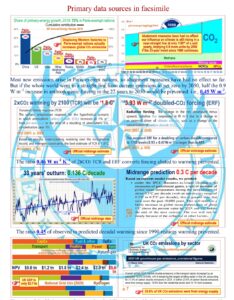Global Threat Assessment Group
How much global warming would worldwide net zero emissions prevent by 2050–
and at what cost?
[Editor’s note: My dear friend, John Remington Graham, retired professor of law, reached out to an authoritative source in an endeavor to ascertain the truth about Global Warming. He received the answer but with a request of anonymity. Here’s their exchange. The STAG REPORT (May 2023) can be downloaded here.
Sent: Monday, May 01, 2023 at 4:01 PM
From: jack.graham@telus.net
To:
Subject: Charles IIIMy Lord, — My guess – and it is only a guess – is that Charles III will be King for about ten years, give or take a year or two. Do you think he will shut up about the scare over global warming? I had my doubts, and I can see that the scientific basis for this ridiculous passion is quickly crumbling, although it becomes more and more popular among politicians who love the idea as an excuse to grab and abuse power. A bogus idea can last only so long. What are your views? I know you must speculate, but would appreciate your thoughts.
From:
Sent: Monday, May 1, 2023 12:20 PM
To: jack.graham@telus.net
Subject: Re: Charles IIIWell, when the Climate King gets the attached (which you did not get from me) he will have to think again.
Sent: Monday, May 01, 2023 at 6:06 PM
From: jack.graham@telus.net
To:
Subject: RE, : Charles IIIMy Lord, — I cannot verify your numbers, but can and do verify the thrust of your excellent essay, which recalls the Democrat presidential debates of 2020 in the United States. Bernie Sanders projected a cool $16 trillion for getting rid of human emissions of CO2, which would make no difference to speak of, would eliminate all prospects of paying off student loans and keeping Social Security solvent, and destroy the United States. This striking reality caused he subject to change in the debates, and now climate change is only a talking point for a few years in hopes that few if any will meanwhile understand the hoax. I think the best presentation was by Professor Lindzen at GWPF in 2018, attached. Ten pages of text which say everything that you need to know, and circumscribes a practical limit to the utility of the idea for the powers of high finance
Sent: Monday, May 1, 2023 3:36 PM
To: jack.graham@telus.net
Subject: Re: Charles IIIActually, you can very easily verify STAG’s numbers, for the calculation is impeccably and explicitly sourced, and nothing more than elementary arithmetic is required.
Senator John Kennedy of Louisiana was told by Administration officials at a hearing that U.S. net zero would cost some $50 trillion. But, as the STAG brief shows, that (probably underestimated) figure would prevent only 1/70th of a degree of global warming.
This value-for-money question is going to become more and more important as the stupefying cost of emissions abatement starts to bite. Once STAG’s calculation is more widely known, the end of the climate nonsense will be nigh.]
OME 70% of new CO2 emissions arise1 in Paris-exempt nations – such as China,2 India3 and Pakistan4 – that are greatly expanding their coal-fired capacity so as to power production priced out of Paris-obligated nations by onerous emissions-abatement measures driving high electricity and compliance costs. Output emissions intensity in Paris-exempt nations exceeds that of Paris-obligated nations, whose substantial and growing sacrifices of businesses, jobs and profits thus paradoxically increase global emissions, helping to sustain the near-linear uptrend5 therein, undiminished since 1990. Here, from mainstream methods and data, it is shown that the uptrend in global temperature6 since 1990 is well below half the then-predicted7 midrange rate, so that even worldwide net zero emissions would prevent less than 0.1°C global warming by 2050. Each $1 bn spent would prevent less than one ten-millionth C warming. Paris-obligated nations have accordingly set themselves at a strategic and costly but pointless terms-of-trade disadvantage.
Context
Some 70% of new greenhouse-gas emissions arise in nations exempt from the Paris climate accord.1 Emissions-abatement legislation in the chiefly Western nations selectively targeted by the accord has greatly increased their electricity and compliance costs, setting them at a severe and deepening terms- of-trade disadvantage against the Paris-exempt nations. Electricity prices8 in Germany and Denmark, at $0.80 kWh–1 for households and $0.60 kWh–1 for businesses, exceed the $0.10 kWh–1 for households and $0.08 kWh–1 for businesses in India and China by an order of magnitude.
China,2 India3 and Pakistan,4 with more than one-third of global population, are greatly expanding their coal-fired generating capacity, not least so as to accommodate production priced out of Paris- obligated nations by their increasingly costly and intrusive emissions-abatement measures, the chief cause of the large and rapidly-growing disparity between Western and Eastern electricity prices.
Particularly where the manufactures displaced are energy-intensive, Eastward transfer of Western jobs and industries increases global emissions (the opposite of what was intended): for manufacturing in Paris-exempt nations emits more per product than in Paris-obligated nations. Sure enough, since the first (1990) report7 of the Intergovernmental Panel on Climate Change, anthropogenic greenhouse-gas forcing has increased at an undiminished, near-linear rate5 of 1.1 Watts per square meter in 33 years, or 1/3rd of a Watt per square meter per decade. Substantial sums spent by Paris-obligated nations on abatement over a third of a century have thus exerted no discernible mitigating effect.
Methods
If – as is likely – the long-run uptrend in anthropogenic greenhouse-gas forcing5 continues for 27 years to 2050, it will grow by another 0.9 W m–2, of which half, ΔQaba on 0.45 [0.35 to 0.55] W m–2, would be abated if all nations moved linearly from current emissions to net zero. For 3.93 [3.46 to 4.4] W m–2 midrange doubled-CO2 effective radiative forcing9, p.925 (ERF) and 1.8 [1.2 to 2.4] C transient doubled- CO2 climate response (TCR) thereto,9, p.93 Monte Carlo distribution (Fig. 1) via Eq. (1) yields the 2 σ interval 0.19 [0.12 to 0.3] C of global warming ΔTX that worldwide net zero would prevent by 2050:
Global warming ∆𝑻𝑿 that worldwide net zero emissions would prevent by 2050


In the 33 years since 1990, when the global scientific community first9 predicted the likely evolution of temperature based on four emissions scenarios A-D, emissions have tracked10 Scenario A (business as usual), which had predicted 0.3 C decade–1 midrange transient warming9, p. xi ΔTprdc. Yet observed warming6 ΔTobs was just 0.136 C decade–1 (with no trend6 in the last nine years). Eq. (2) gives midrange ΔTC after allowing for this factor-2 excess of originally-predicted over subsequently-observed warming:
Corrected warming ∆𝑻𝑪 that worldwide net zero emissions would prevent by 2050

McKinsey Consulting11 has conservatively estimated that the capex cost alone of worldwide net zero would be $275 trillion, or half of global corporate profits. After allowing for opex, typically at least twice capex, total cost might well approach $1 quadrillion. Then every $1 billion spent on attaining net zero (Eq. 3) would prevent only one 10-millionth of a degree of warming – poor value for money:
Global warming ∆𝑻𝑩 prevented by each $1 billion spent on emissions abatement

However, the UK’s national grid authority estimates12 the cost of net-zeroing the grid as $3.6 trillion. Since the grid contributes only 23.6% of national emissions.13 UK net zero might cost $15 trillion – more than six years’ annual GDP over 27 years. Since the UK represents 1% of global emissions.13 UK net zero would prevent only 1/1000th C of warming by 2050, before accounting for the Eastward transfer of UK jobs, increasing global emissions. On the basis of the probably-underestimated12 cost of net-zeroing the UK grid, worldwide net zero might cost $1.5 quadrillion (100 times the UK cost). Then every $1 bn spent on abatement would prevent only one 16-millionth of a degree of warming.
The US represents 15% of global emissions.14 Even if the US were to attain net zero, its contribution to reduced warming by 2050 would be only 1/70th C, and less after adjustment for exported emissions.
Conclusions
If the present 0.136 C decade–1 global-temperature uptrend persists to 2050, by then the world will be less than 0.4°C warmer than now. Even after worldwide net zero it would be less than 0.3°C warmer than now. However, since the most populous Paris-exempt nations are greatly increasing coal-fired capacity, keeping their electricity prices an order of magnitude below Western prices, even the theoretically-achievable 0.1°C reduction will not occur. Instead, exporting Western emissions to the Paris-exempt nations will continue, actually adding to global warming. Thus, net zero would deepen the West’s already-worsening terms-of-trade disadvantage without conferring any benefit on the climate. Even worldwide net zero is unachievable, unaffordable and incapable of significantly reducing future global warming, which, on the trend since 1990, will in any event be small, harmless and net-beneficial.

The ratio 0.46 W m–2 K–1 of 2xCO2 TCR and ERF converts forcing abated to warming prevented.
The ratio 0.45 of observed to predicted decadal warming since 1990 reduces warming prevented.
The ratio of the $3.6 tn cost of net-zeroing the UK grid to the 23.6% of CO2 emissions represented by energy supply is $15.25 trillion, a reasonable first approximation to the true cost of net zero in the UK.
Since the UK represents 1% of global emissions, global net zero might cost $1.5 quadrillion, so that each $1 billion spent on emissions abatement would prevent one 16-millionth°C of warming. But that very large worldwide expenditure would prevent less than 1/10th°C global warming, of which UK net zero would prevent 1%, or less than 1/1000th°C, and US net zero 15%, or about 1/70th°C.
References
- British Petroleum (BP). Statistical Review of World Energy https://www.bp.com/en/global/corporate/news-and-insights/press-releases/bp- statistical-review-of-world-energy-2019.html
- com. China doubles down on coal as energy crunch bites, 2022. https://www.france24.com/en/live-news/20220918-china-doubles-down-on-coal-as- energy-crunch-bites
- com. Analysis: India power binges on coal, outpaces Asia, 2022. https://www.reuters.com/business/cop/india-power-binges-coal-outpaces-asia-2022- 11-18
- com. Pakistan plans to quadruple domestic coal-fired power, move away from gas, 2023.
https://www.reuters.com/business/energy/pakistan-plans-quadruple-domestic-coal- fired-power-move-away-gas-2023-02-13/
- National Oceanographic and Atmospheric Administration (NOAA). Annual greenhouse-gas index [accessed April 2023].
- University of Alabama in Huntsville (UAH). Monthly global mean lower-troposphere temperature anomalies [accessed April 2023].
http://www.nsstc.uah.edu/data/msu/v6.0/tlt/uahncdc_lt_6.0.txt
- IPCC (1990). Houghton, T., et al., eds. Assessment Report prepared for the Intergovernmental Panel on Climate change by Working Group 1. Cambridge University Press, 1990.
- com, Electricity prices by country, 2023.
https://www.globalpetrolprices.com/electricity_prices
- IPCC (2021). Masson-Delmotte, V., et al., eds. Climate Change 2021: The physical science basis. Contribution of Working Group I to the Sixth Assessment Report of the Intergovernmental Panel on Climate Change. Cambridge University Press,
- Friedlingstein, , O’Sullivan, M., Jones, M.W., and Andrew, R.M. Global carbon budget 2022. Earth Sys. Sci. Data 14(11):4811-4900, 2022.
https://essd.copernicus.org/articles/14/4811/2022
- Kumra, G., and Woetzel, J. What it will cost to get to net-zero. McKinsey Global Institute,
https://www.mckinsey.com/mgi/overview/in-the-news/what-it-will-cost-to-get-to-net- zero
- National Grid ESO. Analysing the costs of our Future Energy London, 2020.
https://www.nationalgrideso.com/news/analysing-costs-our-future-energy-scenarios
- Office for National Statistics (ONS). 2021 UK greenhouse gas emissions, provisional Department for Business, Energy & Industrial Strategy, London, 2021.
- Environmental Protection Agency (EPA). Global Greenhouse Gas Emissions,
https://www.epa.gov/ghgemissions/global-greenhouse-gas-emissions-data
Deputy Director (Intelligence), Strategic Threat Assessment Group Boulevard Leopold III, B-1110 Brussels, Belgium
English text May 2023




Younger Dryas Event:
The end of the Younger Dryas, about 11,500 years ago, was particularly abrupt. In Greenland, temperatures rose 10°C (18°F) in a decade.
https://www.ncei.noaa.gov/sites/default/files/2021-11/3%20The%20Younger%20Dryas%20-FINAL%20NOV%20%281%29.pdf
Climate Change on Earth has been going on constantly for billions of years. The undemocratic Democrats, more appropriately called Demonrats. Are using Climate Change as a Shell Game Game or Three Card Monte hucksters. It’s a perfect scam that can be used to make any claim to support any of their many money laundering, profit skimming, and election fraud schemes. It’s a bigger bamboozle than 9/11 or a Democrat orchestrated school shooting.
When is the last time you heard any honest statement coming out of any Deep State connected Democrat?
The Republicons who aren’t much better, if at all, are likely to go long with the Dirty Dems, by referring to them as a “democratic” party which promotes “democratic” legislation from the “democratic” side of the aisle, which could not be further from the truth.
If you want to educate yourself on the reality of climate change listen to these audio and video casts by Randell Carlson:
https://randallcarlson.com/video-podcast/
More past climate change:
https://www.cbsnews.com/colorado/news/tiny-thornton-dinosaur-torosaurus-public-debut-alongside-sue-trex-denver-museum-nature-science/
Another exciting message the museum wants to share.
“When our visitors are out there hiking and walking around or even going to the mall,” said Jennifer Moss Logan, “they can know they are standing right where dinosaurs were.”
She explained that’s because the Front Range is essentially “Dino Central.”